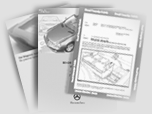Preliminary work:
Diagnosis - Function Test  11 11 |
Preparation for DTC readout
1. Review  11, 11,  12, 12,  13, 13,  20, 20,  21, 21,  22, 22,  23, 23,  31, 31,  32 32
2. Fuses OK.
3. Battery voltage 11 - 14 V
4. SRS MIL (A1e15) illuminates.
5. Connect Hand-Held Tester (HHT) as per connection diagram, see section 0, and readout DTC memory.
 CAUTION! CAUTION!
Do not connect battery trickle charger.
 CAUTION! CAUTION!
Risk of Injury when prforming Diagnostic Tests and repairs on components of the SRS system.
Store both airbags and side airbags with opening surface pointing upward.
Do not expose to temperatures above 100°C.
Interrupt any electrical current from reaching the airbag unit.
Note:
As of 07/93, diagnostic trouble codes (DTC's) can only be read out and erased using the Hand-Held Tester (HHT).
Determine MB number of the SRS control module via HHT
(see DTC chart on page 12/3):
The SRS control modules beginning with the number 000,
the fault code1 is valid.
Those beginning with 001, the fault code 2 is valid.

When installing additional accessories, observe harness clearances near SRS sensor lines.
DTC's for Lower Control Field Control Module (N72) see  12/6 12/6 |
Test equipment; See MBUSA Standard Service Equipment Program
| Hand-Held Tester (HHT) 1) |
See S.I. in groups 58 and 99. |
| 1) Available through the MBUSA Standard Equipment Program. |
DTC

with fault
code 1 |
with fault
code 2 |
Possible cause |
Test step/Remedy 1) |
   |
   |
SRS control module (N2/2) |
 23 23  2.0 2.0 |
   |
   |
Driver AB squib (R12/3) |
 23 23  3.0, 4.0 3.0, 4.0 |
   |
   |
Left front ETR squib (R12/1) |
 23 23  5.0, 6.0 5.0, 6.0 |
   |
   |
Right front ETR squib (R12/2) |
 23 23  7.0, 8.0 7.0, 8.0 |
   |
   |
Front passenger AB squib (R12/8) |
 23 23  9.0, 10.0 9.0, 10.0 |
| |
   |
Left side airbag squib (R12/9) |
 23 23  15.0, 16.0 15.0, 16.0 |
| |
   |
Right side airbag squib (R12/10) |
 23 23  17.0, 18.0 17.0, 18.0 |
   |
      
      
      
   |
Programming does not comply with vehicle version |
 31.0, verify vehicle version, repeat programming. 31.0, verify vehicle version, repeat programming. |
   |
   |
Circuit 15R, voltage supply (low voltage) |
 23 23  1.0 1.0 |
   |
   |
SRS MIL (A1e15) |
 23 23  11.0 11.0 |
   |
   |
Front passenger seat occupied recognition sensor (B41/1) 2) or (B48) |
 23 23  19.0 19.0 |
1) Observe Preparation for Test, see  22. 22.
2) As of model introduction  , other models as of approx. 06/96 , other models as of approx. 06/96 |
DTC

with fault
code 1 |
with fault
code 2 |
Possible cause |
Test step/Remedy 1) |
    |
    |
Left front seat belt buckle switch (AB/ETR) (S68/3) |
 23 23  12.0 12.0 |
    |
    |
Right front seat belt buckle switch (AB/ETR) (S68/4) |
 23 23  13.0 13.0 |
   |
|
Squib short circuit (  ) (to each other) ) (to each other) |
 23 23  14.0 14.0 |
| |
   |
Left side airbag (A53), harness fault |
 23 23  16.0 16.0 |
| |
   |
Left side air bag (A53), sensor defective |
Replace sensor |
| |
   |
Left side air bag (A53), sensor defective |
Replace sensor |
| |
   |
Right side airbag (A54) |
 23 23  18.0 18.0 |
| |
   |
Right side airbag (A54), sensor defective |
Replace sensor |
| |
   |
Right side airbag (A54), sensor defective |
Replace sensor |
| |
   |
Front passenger seat occupied recognition with automatic child seat recognition (B48) (ACSR), communication, -//-,   |
 23 23  20.0 20.0 |
| |
   |
Front passenger seat occupied recognition with automatic child seat recognition (B48) (ACSR),
Improperly positioned child seat or faulty,
Connection between passenger seat and child seat faulty,
B48,
Metallic objects on passenger seat or child seat,
Short term electromagnetic interference in immediate area such as electronic transmitters, telephones etc. |
Position child seat properly or replace,
Replace B48 |
1) Observe Preparation for Test, see  22. 22. |
DTC

with fault
code 1 |
with fault
code 2 |
Possible cause |
Test step/Remedy 1) |
| |
   |
Front passenger seat occupied recognition with automatic child seat recognition (B48) (ACSR) |
Replace B48 |
| |
   |
Left side airbag (A53), communication interference |
Electromagnetic interference,
check harness routing if accessories
installed 2) |
| |
   |
Right side airbag (A54), communication interference |
Electromagnetic interference,
check harness routing if accessories
installed 2) |
| |
   |
Digital crash output, harness fault (TELE AID) 3) |
|
| |
   |
Analoge crash output, harness fault (model 170 Kompressor) |
|
1) Observe Preparation for Test, see  22. 22.
2) Observe clearances near sensors, if additional accessories are being installed.
3) Currently only on model 170 |
 CAUTION! CAUTION!
Risk of Injury when performing Diagnostic Tests and repairs on components of the SRS system.
Store both airbags and side airbags with opening surface pointing upward.
Do not expose to temperatures above 100°C.
Interrupt any electrical current from reaching the airbag unit.
|
 CAUTION! CAUTION!
Risk of injury if airbag units and ETR units are ignited accidentally or if stored with the opening end facing downward which may cause the accidentally ignited components to fly about causing injury. Danger to persons also exists if the components are disposed of by cutting apart with cutting torches or other cutting/separation devices. Danger also exists if disposing the untriggered units via refuse collection or via smelting/carbonizing companies.
Protective measures/Supervision
- Place removed airbag unit with the opening side facing upward.
- Allow only properly trained dealer staff to supervise, purchase, transport, store, test/replace any of the SRS components.
- Install all airbag or ETR units once pulled from the parts department.
- Protect all airbag or ETR units from any sparks, open flame, or temperatures above 100°C.
- Do not transport airbag or ETR units in the passenger compartment, rather transport securely in their original packaging in the trunk.
- Do not allow oil, grease or cleaning agents come in contact with the airbag or ETR units
- Perform SRS tests only with approved test equipment (such as HHT), while installed in the vehicle without occupants.
- When reconnecting the vehicle battery or any outside electrical source, with the ignition turned ON, do not allow any occupants inside the vehicle.
- Airbag or ETR units which have been dropped from a height greater than 18 inches must be replaced.
- Prior to disposing the airbag or ETR units, the units must be made un-useable by discharging.
- In order to render the airbag and ETR unit un-useable, the specially made discharge harness must be used and at the same time maintain
a safe distance of at least 33 feet from the units being discharged.
Prior to undertaking any chassis/body repairs, installation/repair work on airbag and ETR units, or any components which come in contact with the airbag and ETR units, or are part of the electrical circuit of airbag and ETR units (such as installation of the steering wheel), the following conditions must be met:
- Remove ignition key.
- Disconnect any outside source of elctrical circuit (i.e. battery charger).
- When performing interior repairs or welding operations, disconnect the connector from the SRS control module. |
Preparation for DTC readout for Lower Control Field Control Module (N72) only
1. Connect Hand-Held Tester (HHT) as per connection diagram, see section 0, and readout DTC memory for lower control field control module (N72),
2. Review  12, 12,  13, 13,
2. Listed below are only the DTC's pertaining to SRS,
3. Fuses OK,
4. Battery voltage 11 - 14 V,
5. SRS MIL (A1e15) illuminates.
|
DTC
 |
Possible cause |
Test step/Remedy 1) |
     |
Automatic child seat recognition warning lamp (N72e1)
  - short circuit to ground, -//- open circuit - short circuit to ground, -//- open circuit |
 23 23  22.0 22.0 |
     |
ACSR signal line
  - short circuit to ground - short circuit to ground |
 23 23  20.0 20.0 |
1) Observe Preparation for Test, see  22. 22. |
|


 Printable version
Printable version


 11
11 CAUTION!
CAUTION! 

 Resistance too great.
Resistance too great. 
 - Short circuit to ground (GND)
- Short circuit to ground (GND) 


 2.0
2.0









 , other models as of approx. 06/96
, other models as of approx. 06/96